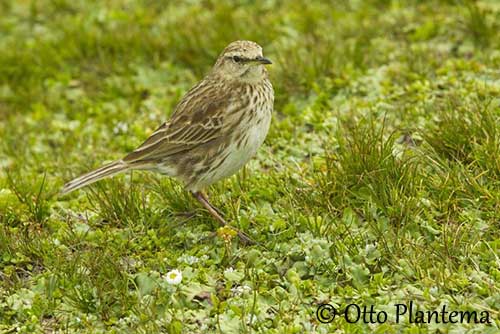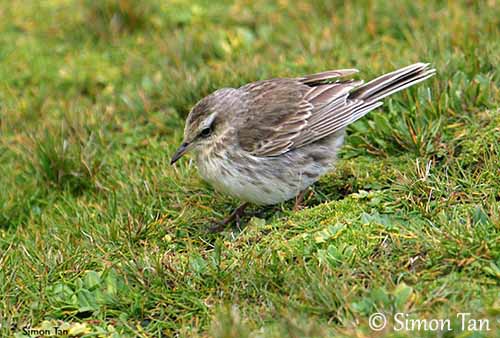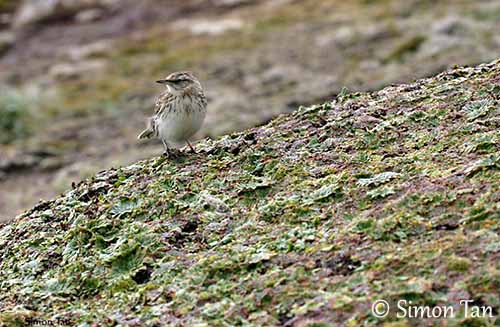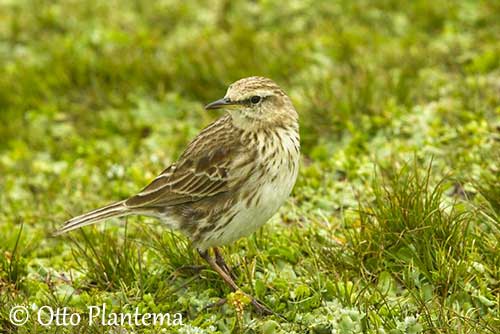
Fr: Pipit austral ou Pipit de Nouvelle Zélande
Ang: New Zealand Pipit – Australasian Pipit
Maori: Pihoihoi
All: Neuseeland Spornpieper
Esp: Bisbita de Richard
Ita: Calandro maggiore della Nuova Zelanda
Nd: Nieuw-Zeelandse Pieper
Sd: Nya Zeelandpiplärka
Photographers:
Otto Plantema
Trips around the world
Simon Tan
PBase Bird galleries
Text by Nicole Bouglouan
Sources :
HANDBOOK OF THE BIRDS OF THE WORLD Vol 9 - by Josep del Hoyo - Andrew Elliot - David Christie - Lynx Edicions - ISBN: 8487334695
KNOW YOUR NEW ZEALAND BIRDS by Lynnette Moon - New Holland Publishers – ISBN: 1869660897
BirdLife International (BirdLife International)
New Zealand bird status between 2008 and 2012
New Zealand birds and birding (Narena Olliver)
Te Ara – The Encyclopedia of New Zealand
Tiritiri Matangi Open Sanctuary
Birding West Coast – New Zealand
New Zealand Pipit or Australasian Pipit
Anthus novaeseelandiae
Passeriformes Order - Motacillidae Family
INTRODUCTION:
The New Zealand Pipit or Australasian Pipit is widespread throughout New Zealand and occurs on several islands too. Pipits are birds of open country which have benefited from land clearance. They frequent a wide variety of habitats, from the tideline to high-elevation grasslands.
The Maori name is “Pihoihoi”, related to their repeated to-and-fro movements.
It is now considered a distinct endemic New Zealand bird species, and each subspecies is endemic to its own region. From 8 subspecies including formerly Australian and Tasmanian birds, only 4 subspecies are now included in Anthus novaeseelandiae, endemic to New Zealand and some sub Antarctic islands.
DESCRIPTION OF THE BIRD:
Biometrics:
Length: 18 cm
Weight: 35 g
The adult of nominate race has brown to brownish upperparts with pale buff-edged feathers and blackish centres, forming streaked and mottled pattern. The rump is more uniform. The tail is brown. On the upperwing, greater wing-coverts and inner secondaries are edged buffy-white. The flight feathers are dark brown.
On the underparts, chin, throat and foreneck are white. Breast and neck side are buff-white with dark brown mottling. Belly and undertail-coverts are white, and the white flanks show weak dark streaking.
On the head, we can see a narrow, white supercilium. There is a dark eye stripe, less distinct in front of the eye than behind where it is broader and conspicuous. The ear-coverts are fawn-coloured. The blackish moustachial and malar stripes contrast with the white submoustachial stripe.
The bill is brown or horn-coloured, with pinkish to horn base of lower mandible. The eyes are dark brown. Legs and feet are pale pinkish-brown.
Both sexes are similar and the juvenile resembles adults.

SUBSPECIES AND RANGE:
The New Zealand Pipit or Australasian Pipit has four subspecies.
A.n. novaeseelandiae (described here) occurs in New Zealand including North, South and Stewart Islands.
A.n. chathamensis from Chatham Islands. This race has buffer feather edges and underparts than nominate.
A.n. aucklandicus (displayed) is found on Auckland and Campbell Islands. This one has more fulvous plumage with less white on the underparts.
A.n. steindachneri from Antipodes Islands. This race is more fulvous than “aucklandicus”. The brown upperparts show pale brown feather edges. Throat and breast are cream with slight brown streaking, and the belly is pale pinkish-brown.
HABITAT:
The New Zealand Pipit or Australasian Pipit frequents a variety of open habitats from coasts to alpine shrubland, up to 1900/2000 metres of elevation above the tree line.
It can often be seen along rivers and coastlines, near beaches, in rough grasslands, roadsides, scrubby pastures, tussock land, forest edges, riverbeds and estuaries.
The species is common in farmland and open shrubland on Chatham and Pitt islands. On Auckland, Campbell and Antipodes Islands, it frequents open habitats and tussock grasslands.
CALLS AND SONGS: SOUNDS BY XENO-CANTO
The New Zealand Pipit or Australasian Pipit often sings from prominent perch. It utters high-pitched musical trills commonly including “scree” and “pee-it” sounds. The main call is a strident “tzweep” given all year round. The song is given while flying over the territory.

BEHAVIOUR IN THE WILD:
The New Zealand Pipit or Australasian Pipit is primarily an insect-eater, feeding mainly on numerous invertebrates such as beetles, wasps, flies, crickets, spiders, grubs, larvae, snails and crustaceans. It can find sand hoppers on the beaches too.
Outside the breeding season, they may feed in loose flocks where there are abundant insects. But it finds larvae and worms in freshly ploughed fields. It may hawk insects while perching on high posts. It also takes some seeds of grass, clovers and thistles.
The New Zealand Pipit or Australasian Pipit pair remains all year round on the territory and the same mates breed together year after year.
This species frequently flicks its tail while walking. These movements can be used as signals between flock members. During courtship and territorial displays, the bird performs exaggerated tail-wagging.
They are monogamous and breed when insects are abundant. Both mates display together. They extend wings and tail, and jump over and around each other. They probably perform flight displays like other pipit species.
The New Zealand Pipit or Australasian Pipit is mainly sedentary, but local movements are observed outside the breeding season. They may form flocks of up to 100 birds.
The flight is powerful and undulating.

REPRODUCTION OF THIS SPECIES:
The breeding season occurs from September to February.
The female builds the nest, a bulky structure with deep cup made with woven grass and lined with moss and lichen. The nest is on the ground, well hidden on steep bank at base of clump of grass, tussock, fern or bush.
The female lays 3-4 creamy eggs with brown markings. She incubates during 14-15 days. The chicks are fed by both parents, and fledge about two weeks after hatching.
The nests can be attacked by magpies and rats, but the species has benefited from rat eradication on some islands. The eradication of mice from Antipodes islands is in progress and could be done at the end of this month (July 2014), managed by the Department of Conservation.
PROTECTION / THREATS / STATUS:
The New Zealand Pipit or Australasian Pipit is usually common in its range and the populations appear stable, but the numbers are unknown.
The species has benefited from land clearance, but these birds are affected by grazing and drainage of wetlands. The New Zealand Falcon is one of its predators in central North Island. In addition, the use of insecticides for agriculture reduced the food supply.
But currently, this pipit is evaluated as least Concern.
